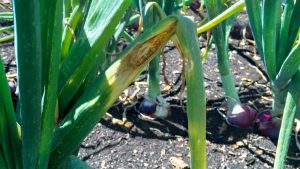Onion growers have new tool versus fungicide-resistant disease
by Katie Navarra
In New York state, onions are grown in areas sometimes referred to as muck lands – former swamps now filled with organically rich soil that boosts productivity.

Five years ago, however, onion growers started reporting large incidents of premature leaf death in their fields. It affected nearly 75percent of growers’ crops and put a dent in the state’s onion industry, which has a four-year average value of $44.7 million, based on data from the U.S. Department of Agriculture.
Onions are at risk for many foliar diseases – such as Botrytis leaf blight, purple blotch and downy mildew – but this time, researchers identified the culprit as Stemphylium leaf blight (SLB), a relatively new and increasingly devastating disease.
“The short-term losses can be staggering,” said onion farmer Matt Mortellaro, co-owner of G. Mortellaro & Sons in Elba, New York. “It can result in a total crop failure if it takes hold in a field.”
A recently published study from researchers at Cornell AgriTech has identified better ways to manage SLB and use fungicide more effectively.
“Onion growers in New York are completely reliant on fungicides for managing SLB,” said co-author Sarah Pethybridge, associate professor of plant pathology and plant-microbe biology. “The development of fungicide resistance means growers are faced with a rapidly reducing set of fungicides with which to rotate, leading to increased selection pressure for resistance in the fungicides remaining.”
The increase of fungicide resistance is a major reason why SLB has recently become the dominant foliar pathogen in onions. The disease first appeared in New York in 1985 but only caused significant damage during the 1990, ’91 and ’92 growing seasons, before re-emerging in 2011.
That’s when study co-author Christy Hoepting, an extension vegetable specialist at Cornell Cooperative Extension in Orleans County, started receiving calls from concerned growers about premature leaf death and smaller onion bulbs. She realized the symptoms were similar to SLB, so she sent some field samples to Pethybridge and Frank Hay, senior extension associate in the School of Integrative Plant Science.
“Our first step was to look at the pathogens and determine what the main diseases were,” said Hay, the study’s lead author. “We were surprised to see Stemphylium leaf blight disease because it had been seen as a minor disease of onion compared to others.”
In the laboratory, Pethybridge and Hay grew samples of the fungus on artificial media and exposed them to varying concentrations of each fungicide. By evaluating how different fungicides inhibited the pathogen’s growth, they could determine which fungicides were most effective against SLB.
Fungicides are organized into groups depending on which cellular process they attack within the fungus. Laboratory and field trials demonstrated that Stemphylium had developed geographically widespread resistance to at least two groups of fungicides, and that other fungicide groups were at risk of developing resistance.
Growers quickly adopted guidelines to reduce the onset of fungicide resistance, including limiting the number of applications of any particular fungicide group each season, and rotating between fungicides groups.
“Managing Stemphylium with fungicides is like whitewater rafting: The effective fungicides keep falling out of the boat as we negotiate the rapids,” Hoepting said. “Our work will prevent crop losses in a high-pressure year because we will ensure that growers will be using fungicides that work instead of those that SLB is resistant to.”
The researchers plan to develop molecular and genetic tools that will help detect fungicide resistance faster, and they hope to identify a disease prediction model to accurately guide growers’ fungicide use.
“Christy and her colleagues have been instrumental in helping us determine what concentrations are still effective,” Mortellaro said, “and to help us strategize our fungicide use so we don’t lose these materials as time goes on.”
This research was supported by funding from the USDA National Institute of Food and Agriculture, a USDA Specialty Crop Block Grant and the Federal Capacity Fund Initiative.


